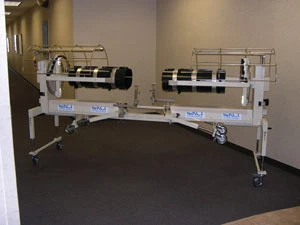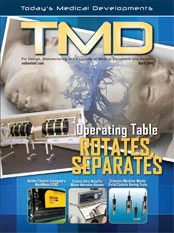
Surgery to separate conjoined twins is always a delicate operation, characterized by a long period of planning, training and rehearsal before the surgery. When the twins are joined at the head – craniopagus – the surgery takes on added significance.
While the planning, done by the medical staff, receives a great deal of media coverage, little attention is typically given to the equipment used during the actual operation. One of the most critical pieces of equipment is the operating table.
Until recently, medical teams had to make do with conventional tables, and they had little freedom to move or rotate the patients as needed. Holding the patients in the proper orientation was also difficult because the angle of conjunction can vary widely; the tables can restrict access to certain parts of the patients' bodies.
Recognizing the shortcomings of conventional operating tables for conjoined twins, surgeons at the World Craniofacial Foundation in Dallas consulted with hospital bed manufacturer KCI USA Inc. of San Antonio, TX in 2002 about designing an operating table to meet the critical needs of craniopagus twins.

Designer John Vrzalik (right) and Registered Nurse Jose Sablan (left) from KCI USA prepare for surgery on Ahmed and Mohamed Ibrahim.
Initially, the surgical team was able to describe their needs in only the broadest of terms. For example, they wanted a table that could support the twins at the proper angle and rotate 360° to allow access to the entire skull area from above. With conventional tables, surgeons do as much work as possible from above, then literally move under the table to complete the separation from below. The surgeons also wanted a table that could be separated after surgery so teams could complete the operation on each child independently, and in separate operating rooms if necessary.
Table Design
KCI has manufactured rotating beds for adults and children since 1977. Now they had to devise a rotating pediatric operating table in time for surgery on Ahmed and Mohamed Ibrahim.
The KCI team started by modifying an existing adult bed by cutting it in half to create a table with two rigid surfaces cantilevered from each end, and open in the middle. However, a rigid beam joined the two halves, and the surfaces could not rotate away from each other to give doctors easy access to the separated twins to complete the surgery.
One additional requirement that came to light was that the surgeons needed to put the children into cranial halos to keep their heads fixed during and after surgery. The halos were to be mounted to the table and attached to the children by screws inserted into their skulls. Therefore, the tables had to be parallel and concentric, and had to turn in perfect alignment to avoid putting pressure on the halos.
New Approach
Nine months prior to surgery on the Ibrahim twins, KCI went back to the drawing board. They spent the next six months designing and testing a new table, then teaching hospital staff how to operate it.
For the new table, KCI retained the basic cantilever design in which two rotating operating tables extend from uprights at each end of the unit. A removable link under the tables connects the two halves together. The connecting link can be adjusted to align the tables so that the rotating parts are perfectly concentric and rotate about a common axis.
To ensure smooth rotation and to avoid applying undue force on the halos, KCI assembled zero backlash chain drives in the end uprights. This was tough precision work because of the tight confines of the uprights; the chain drives are operated by a manual crank on either end of the connected unit and transfer rotation to a drive shaft beneath the tables. This allows the two tables to rotate in unison. The driveshaft has a clutch that can be disconnected to skew the beds to the proper starting alignment.
The patients are cocooned in clamshells that contain foam padding and air bladders to hold the children securely in place. The air bladders are inflated by hand bulb to hold the children tightly during rotation, then deflated slightly so as not to restrict their breathing.
"We had never turned patients from supine to prone while being held in halos," says KCI Designer John Vrzalik. "Because of all the unusual requirements, the design team – three engineers and an RN – were in the operating room during the surgery to operate the tables."

A driveshaft allows both beds to be rotated from one end of the joined unit.
To ensure that the tables rotate 360° while maintaining consistent alignment of the halos, KCI designers align the beds using measurement devices that are temporarily mounted to each operating table, ensuring a constant dimension throughout the travel. The distance between bars is maintained to within 1/64".
The tables are raised and lowered with a cranked hydraulic system on each end. The cranks have to be turned in unison to maintain level alignment.
When the tables are separated at the end of surgery, each must be supported by four casters. However, KCI engineer could not be certain of how level the operating room floor was; therefore, supporting the connected bed on eight casters (four for each half) could potentially twist the tables, placing stress on the patients' heads.
To avoid this problem, KCI devised an ingenious set up in which the two pairs of casters closest to center are raised off the floor when the tables are connected. The four end casters support the entire unit, and the connect ing link carries the weight at the center. When the tables are separated, the center casters swing into position to support the individual tables.
The Day of Surgery
Surgery on the Ibrahim twins took place on October 11, 2003, at Children's Medical Center in Dallas. KCI's three bed designers were present to assist medical personnel in adjusting the bed. Everything went as planned, and the rotat ing tables worked flawlessly. However, in an unexpected move, the surgeons asked if the tables could be pulled apart horizontally from each other. They were working in a very narrow area, and while they had cut completely through the skull bones, they were not sure they had fully separated other tissue. They wanted to move the boys apart slightly to see what other work needed to be done.
Unfortunately, the bed was not designed with this capability. Separating the tables horizontally required disconnecting the supporting link and driveshaft, so that the tables would no longer rotate in unison and might lose their alignment. However, since the skull bones were separated, uniform rotation was no longer critical. So, says Vrzalik, "We improvised by disconnecting the frames and manually separating the tables slightly to achieve final separation of the twins." To perform this operation, the KCI personnel literally got under the bed, disconnected the link and driveshaft, lowered the center casters, and manually pushed the beds apart by fractions of an inch.
Second Generation
During the Ibrahim surgery, KCI designers recognized that some changes needed to be made to perfect the operating table. For example, they added a rack and pinion to each operating table to allow horizontal travel while the tables are still connected. Now, the tables can be separated slightly, and the tables will still rotate in unison. In addition, they modified the hydraulic system so that the tables can be raised and lowered from one end.
The first design did not provide easy access to the patients in the event of cardiac arrest during surgery. The latest design includes a slot in the restraining cocoons to allow use of rigid CPR boards if needed.
According to Vrzalik, the design of the new operating table created some unique design and fabrication requirements. "Reliability was a huge concern because we could only do simulated testing prior to the surgery and actual use of the tables. But the beds functioned exactly the way they were designed."
The new design was used for the successful separation surgery of Crystal and Cristina Molina at Loma Linda Medical Center in California, in March 2005. It was also to be used in the surgery for Anastasia and Tatiana Dogaru, but that separation was suspended when the doctors determined that it would not be in the best interest of the children.

Explore the April 2008 Issue
Check out more from this issue and find your next story to read.
Latest from Today's Medical Developments
- Humanoid robots to become the next US-China battleground
- Air Turbine Technology’s Air Turbine Spindles 601 Series
- Copper nanoparticles could reduce infection risk of implanted medical device
- Renishaw's TEMPUS technology, RenAM 500 metal AM system
- #52 - Manufacturing Matters - Fall 2024 Aerospace Industry Outlook with Richard Aboulafia
- Tariffs threaten small business growth, increase costs across industries
- Feed your brain on your lunch break at our upcoming Lunch + Learn!
- Robotics action plan for Europe





